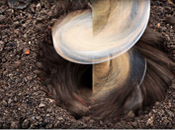
The shale energy boom is this decade's greatest investment theme. . .and it's only going to get bigger.
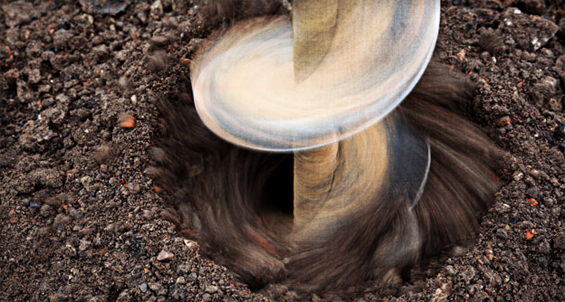
That was the key point I introduced in [my last] essay. I told you there are roughly 6.1 trillion barrels of oil remaining in shale. . .and we could expect to recover about 5% of that, or 300 billion barrels.
That's more oil than the U.S. has produced in the history of the oil industry AND all the oil reserves we have today.
And new drilling innovations—which have occurred in just the past year or two—will help us tap it. . .
You see, although we've made great strides in drilling technology, our ability to exploit shale for oil is still in its infancy. Even the giant Bakken Shale in North Dakota, which is the most mature of the shale-oil plays, is only a little over a decade old.
This is still a brand-new science. That means we are still figuring out the right way to extract oil economically.
Take hydraulic fracturing or "fracking," for example. Fracking rocks isn't new. It began back in the 1950s, when crews would drop "torpedoes" (metal cylinders filled with nitroglycerine) down the well hole. When the torpedo hit bottom, it exploded, cracking the rocks and showering everyone within 100 yards with rock chips, water, and oil.
Today, we use water, sand, and giant pumps.
You see, when drillers hydraulically frack a well, they do a few things: First, they drill down. . .and then drill horizontally. Drillers then create fractures in the rock using high-pressure water jets. Next, they force sand into those fractures. The sand, called "proppant," holds the rock fractures open and allows the oil and gas to flow out.
This new technique improved the economics of shale wells.
But in 2012, professors at Texas Tech University developed a twist on fracking, called "zipper fracking." This is when operators drill two wells side by side. Once both wells are completed, they're fracked at the same time.
As you can see in the diagram below, the fractures form a zipper pattern that cracks the rocks more deeply and efficiently than in a single well. The process allows both wells to produce more oil and gas. In the Barnett Shale in Texas, the zipper-fracked wells doubled the volume of a typical well.
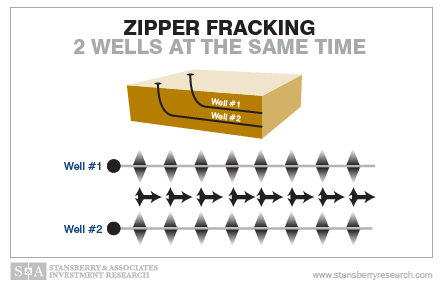
Another one of the largest cost-saving techniques came from the offshore oil industry. When you're drilling wells offshore, it isn't feasible to build a platform, or pad, for each well. So out on the ocean, they drill several wells from a single pad.
Onshore shale drillers quickly adopted that technique for themselves. Because shale is a uniform layer of rock, companies can drill the wells close to each other. Since the drillers don't have to move the rigs too far between holes, the method saves time and money. The process of taking down and setting up a drill rig can take days and cost a company hundreds of thousands of dollars.
Many shale layers, like those in the Bakken and the Eagle Ford and Permian Basin in Texas, are stacked like pancakes. Companies can drill many wells into these layers. The infographic below shows the concept of "stacked laterals" from a single pad.
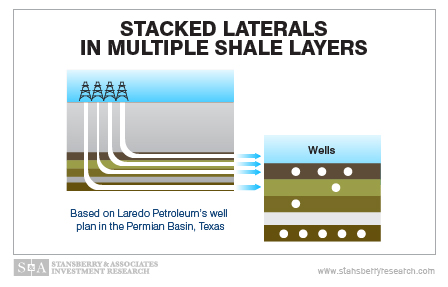
I based this diagram on oil producer and S&A Resource Report holding Laredo Petroleum's actual work in the Permian Basin. According to the company, its 64 wells in four shale layers will recover 44 million barrels of oil. If it only targeted the top layer, it would recover just 12 million barrels of oil.
The stacked laterals increase its production by nearly fourfold.
With so many layers to drill, the company has over 3,500 well locations. . .and roughly 1.6 billion barrels of oil equivalent. That's 35 years' worth of drilling to do.
In the table below, you can see that new drilling innovations like zipper fracking and stacked laterals are dramatically increasing production in all the major shale plays. It shows the barrels of oil produced per drilling rig in June 2011 and June 2014.
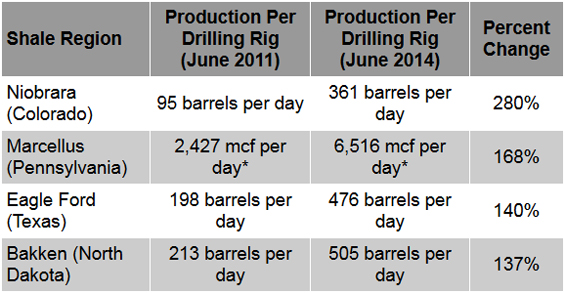
In short, U.S. oil production is soaring. And it will continue to soar as companies find innovative ways to extract it more economically. The shale energy boom is only going to get bigger.
Matt Badiali
The Daily Reckoning

























































